EDU30014 | Health and Physical Education
VerifiedAdded on 2022/08/25
|6
|2469
|112
AI Summary
Contribute Materials
Your contribution can guide someone’s learning journey. Share your
documents today.
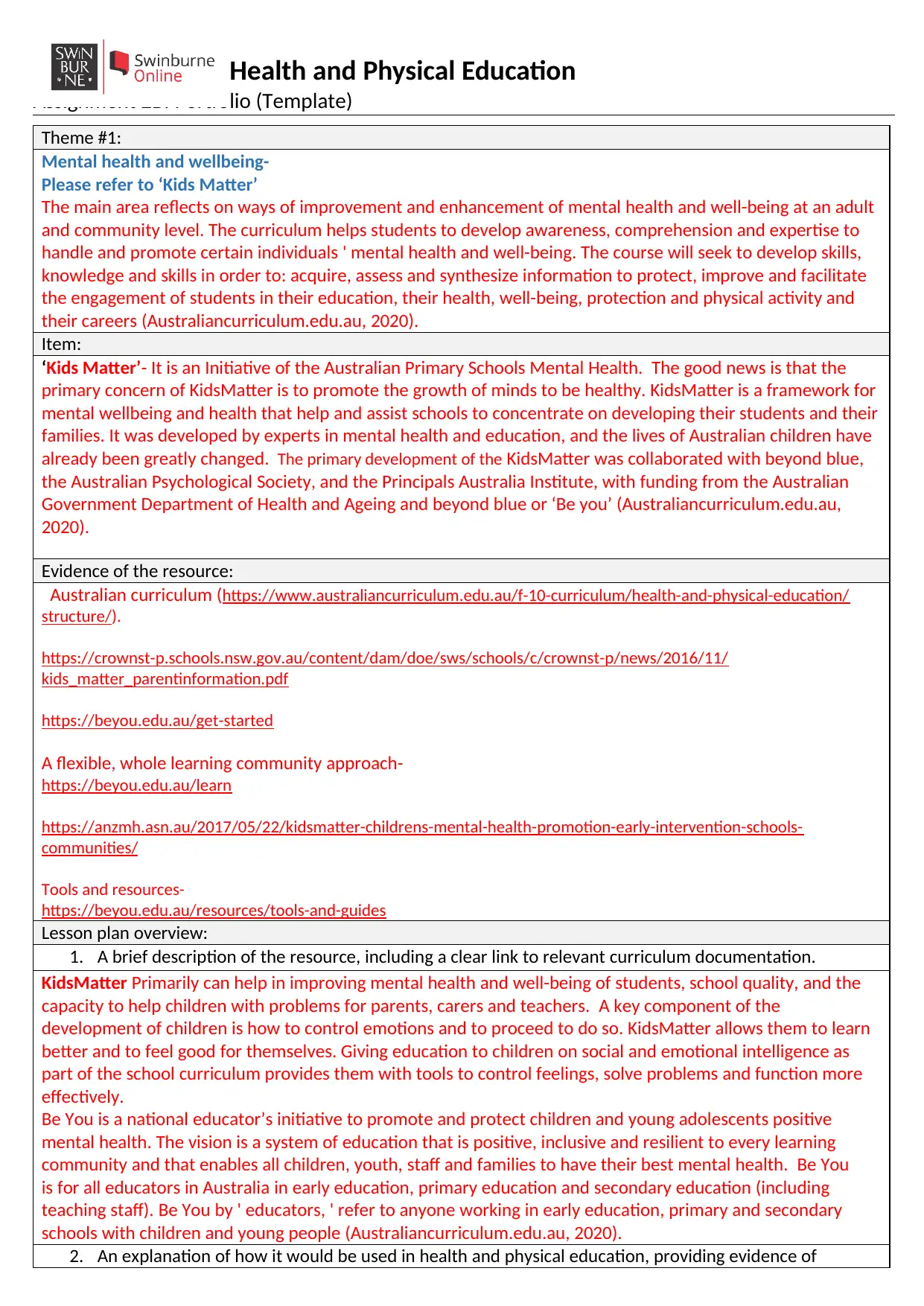
EDU30014: Health and Physical Education
Assignment 2B: Portfolio (Template)
Theme #1:
Mental health and wellbeing-
Please refer to ‘Kids Matter’
The main area reflects on ways of improvement and enhancement of mental health and well-being at an adult
and community level. The curriculum helps students to develop awareness, comprehension and expertise to
handle and promote certain individuals ' mental health and well-being. The course will seek to develop skills,
knowledge and skills in order to: acquire, assess and synthesize information to protect, improve and facilitate
the engagement of students in their education, their health, well-being, protection and physical activity and
their careers (Australiancurriculum.edu.au, 2020).
Item:
‘Kids Matter’- It is an Initiative of the Australian Primary Schools Mental Health. The good news is that the
primary concern of KidsMatter is to promote the growth of minds to be healthy. KidsMatter is a framework for
mental wellbeing and health that help and assist schools to concentrate on developing their students and their
families. It was developed by experts in mental health and education, and the lives of Australian children have
already been greatly changed. The primary development of the KidsMatter was collaborated with beyond blue,
the Australian Psychological Society, and the Principals Australia Institute, with funding from the Australian
Government Department of Health and Ageing and beyond blue or ‘Be you’ (Australiancurriculum.edu.au,
2020).
Evidence of the resource:
Australian curriculum (https://www.australiancurriculum.edu.au/f-10-curriculum/health-and-physical-education/
structure/).
https://crownst-p.schools.nsw.gov.au/content/dam/doe/sws/schools/c/crownst-p/news/2016/11/
kids_matter_parentinformation.pdf
https://beyou.edu.au/get-started
A flexible, whole learning community approach-
https://beyou.edu.au/learn
https://anzmh.asn.au/2017/05/22/kidsmatter-childrens-mental-health-promotion-early-intervention-schools-
communities/
Tools and resources-
https://beyou.edu.au/resources/tools-and-guides
Lesson plan overview:
1. A brief description of the resource, including a clear link to relevant curriculum documentation.
KidsMatter Primarily can help in improving mental health and well-being of students, school quality, and the
capacity to help children with problems for parents, carers and teachers. A key component of the
development of children is how to control emotions and to proceed to do so. KidsMatter allows them to learn
better and to feel good for themselves. Giving education to children on social and emotional intelligence as
part of the school curriculum provides them with tools to control feelings, solve problems and function more
effectively.
Be You is a national educator’s initiative to promote and protect children and young adolescents positive
mental health. The vision is a system of education that is positive, inclusive and resilient to every learning
community and that enables all children, youth, staff and families to have their best mental health. Be You
is for all educators in Australia in early education, primary education and secondary education (including
teaching staff). Be You by ' educators, ' refer to anyone working in early education, primary and secondary
schools with children and young people (Australiancurriculum.edu.au, 2020).
2. An explanation of how it would be used in health and physical education, providing evidence of
Assignment 2B: Portfolio (Template)
Theme #1:
Mental health and wellbeing-
Please refer to ‘Kids Matter’
The main area reflects on ways of improvement and enhancement of mental health and well-being at an adult
and community level. The curriculum helps students to develop awareness, comprehension and expertise to
handle and promote certain individuals ' mental health and well-being. The course will seek to develop skills,
knowledge and skills in order to: acquire, assess and synthesize information to protect, improve and facilitate
the engagement of students in their education, their health, well-being, protection and physical activity and
their careers (Australiancurriculum.edu.au, 2020).
Item:
‘Kids Matter’- It is an Initiative of the Australian Primary Schools Mental Health. The good news is that the
primary concern of KidsMatter is to promote the growth of minds to be healthy. KidsMatter is a framework for
mental wellbeing and health that help and assist schools to concentrate on developing their students and their
families. It was developed by experts in mental health and education, and the lives of Australian children have
already been greatly changed. The primary development of the KidsMatter was collaborated with beyond blue,
the Australian Psychological Society, and the Principals Australia Institute, with funding from the Australian
Government Department of Health and Ageing and beyond blue or ‘Be you’ (Australiancurriculum.edu.au,
2020).
Evidence of the resource:
Australian curriculum (https://www.australiancurriculum.edu.au/f-10-curriculum/health-and-physical-education/
structure/).
https://crownst-p.schools.nsw.gov.au/content/dam/doe/sws/schools/c/crownst-p/news/2016/11/
kids_matter_parentinformation.pdf
https://beyou.edu.au/get-started
A flexible, whole learning community approach-
https://beyou.edu.au/learn
https://anzmh.asn.au/2017/05/22/kidsmatter-childrens-mental-health-promotion-early-intervention-schools-
communities/
Tools and resources-
https://beyou.edu.au/resources/tools-and-guides
Lesson plan overview:
1. A brief description of the resource, including a clear link to relevant curriculum documentation.
KidsMatter Primarily can help in improving mental health and well-being of students, school quality, and the
capacity to help children with problems for parents, carers and teachers. A key component of the
development of children is how to control emotions and to proceed to do so. KidsMatter allows them to learn
better and to feel good for themselves. Giving education to children on social and emotional intelligence as
part of the school curriculum provides them with tools to control feelings, solve problems and function more
effectively.
Be You is a national educator’s initiative to promote and protect children and young adolescents positive
mental health. The vision is a system of education that is positive, inclusive and resilient to every learning
community and that enables all children, youth, staff and families to have their best mental health. Be You
is for all educators in Australia in early education, primary education and secondary education (including
teaching staff). Be You by ' educators, ' refer to anyone working in early education, primary and secondary
schools with children and young people (Australiancurriculum.edu.au, 2020).
2. An explanation of how it would be used in health and physical education, providing evidence of
Secure Best Marks with AI Grader
Need help grading? Try our AI Grader for instant feedback on your assignments.
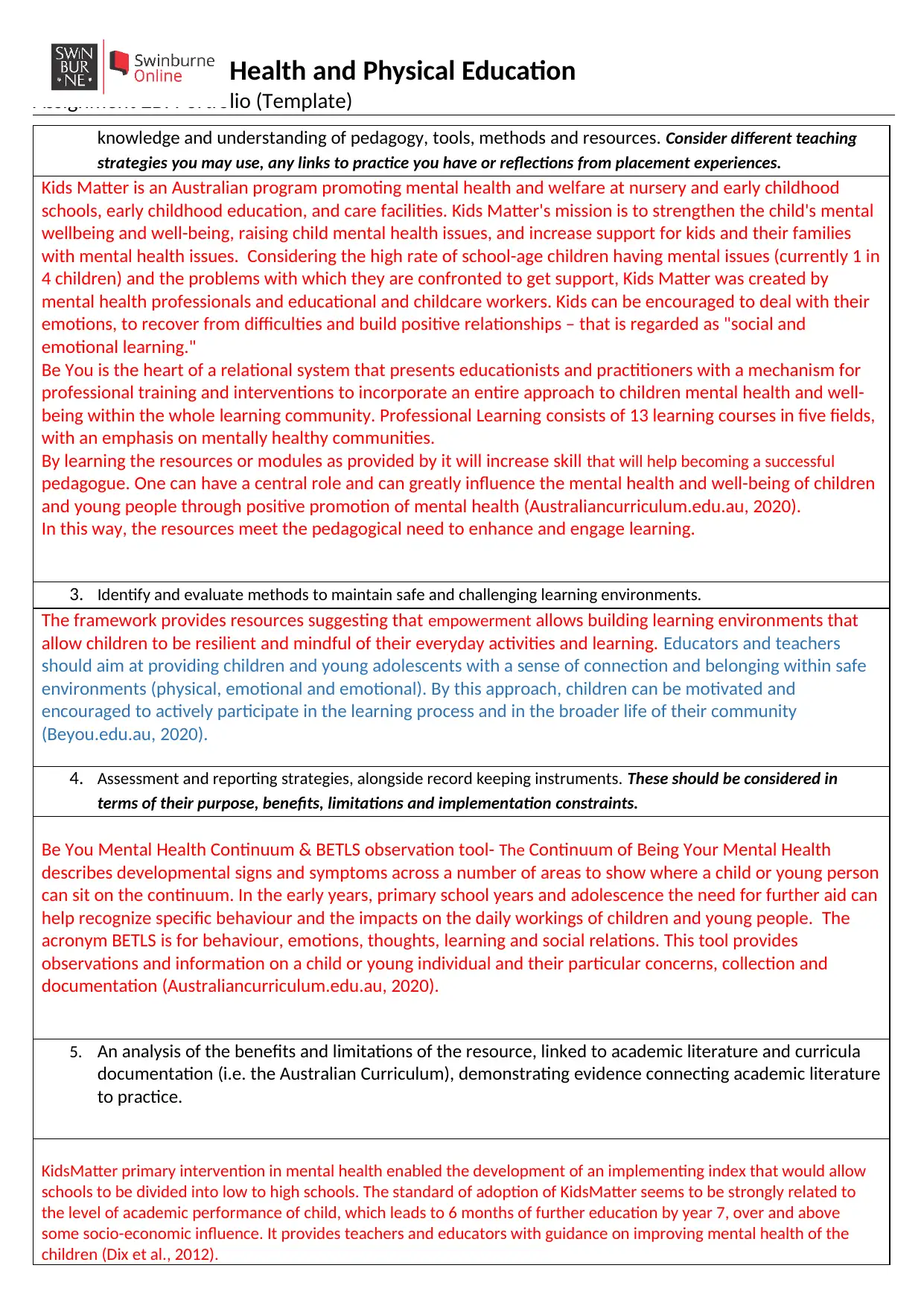
EDU30014: Health and Physical Education
Assignment 2B: Portfolio (Template)
knowledge and understanding of pedagogy, tools, methods and resources. Consider different teaching
strategies you may use, any links to practice you have or reflections from placement experiences.
Kids Matter is an Australian program promoting mental health and welfare at nursery and early childhood
schools, early childhood education, and care facilities. Kids Matter's mission is to strengthen the child's mental
wellbeing and well-being, raising child mental health issues, and increase support for kids and their families
with mental health issues. Considering the high rate of school-age children having mental issues (currently 1 in
4 children) and the problems with which they are confronted to get support, Kids Matter was created by
mental health professionals and educational and childcare workers. Kids can be encouraged to deal with their
emotions, to recover from difficulties and build positive relationships – that is regarded as "social and
emotional learning."
Be You is the heart of a relational system that presents educationists and practitioners with a mechanism for
professional training and interventions to incorporate an entire approach to children mental health and well-
being within the whole learning community. Professional Learning consists of 13 learning courses in five fields,
with an emphasis on mentally healthy communities.
By learning the resources or modules as provided by it will increase skill that will help becoming a successful
pedagogue. One can have a central role and can greatly influence the mental health and well-being of children
and young people through positive promotion of mental health (Australiancurriculum.edu.au, 2020).
In this way, the resources meet the pedagogical need to enhance and engage learning.
3. Identify and evaluate methods to maintain safe and challenging learning environments.
The framework provides resources suggesting that empowerment allows building learning environments that
allow children to be resilient and mindful of their everyday activities and learning. Educators and teachers
should aim at providing children and young adolescents with a sense of connection and belonging within safe
environments (physical, emotional and emotional). By this approach, children can be motivated and
encouraged to actively participate in the learning process and in the broader life of their community
(Beyou.edu.au, 2020).
4. Assessment and reporting strategies, alongside record keeping instruments. These should be considered in
terms of their purpose, benefits, limitations and implementation constraints.
Be You Mental Health Continuum & BETLS observation tool- The Continuum of Being Your Mental Health
describes developmental signs and symptoms across a number of areas to show where a child or young person
can sit on the continuum. In the early years, primary school years and adolescence the need for further aid can
help recognize specific behaviour and the impacts on the daily workings of children and young people. The
acronym BETLS is for behaviour, emotions, thoughts, learning and social relations. This tool provides
observations and information on a child or young individual and their particular concerns, collection and
documentation (Australiancurriculum.edu.au, 2020).
5. An analysis of the benefits and limitations of the resource, linked to academic literature and curricula
documentation (i.e. the Australian Curriculum), demonstrating evidence connecting academic literature
to practice.
KidsMatter primary intervention in mental health enabled the development of an implementing index that would allow
schools to be divided into low to high schools. The standard of adoption of KidsMatter seems to be strongly related to
the level of academic performance of child, which leads to 6 months of further education by year 7, over and above
some socio-economic influence. It provides teachers and educators with guidance on improving mental health of the
children (Dix et al., 2012).
Assignment 2B: Portfolio (Template)
knowledge and understanding of pedagogy, tools, methods and resources. Consider different teaching
strategies you may use, any links to practice you have or reflections from placement experiences.
Kids Matter is an Australian program promoting mental health and welfare at nursery and early childhood
schools, early childhood education, and care facilities. Kids Matter's mission is to strengthen the child's mental
wellbeing and well-being, raising child mental health issues, and increase support for kids and their families
with mental health issues. Considering the high rate of school-age children having mental issues (currently 1 in
4 children) and the problems with which they are confronted to get support, Kids Matter was created by
mental health professionals and educational and childcare workers. Kids can be encouraged to deal with their
emotions, to recover from difficulties and build positive relationships – that is regarded as "social and
emotional learning."
Be You is the heart of a relational system that presents educationists and practitioners with a mechanism for
professional training and interventions to incorporate an entire approach to children mental health and well-
being within the whole learning community. Professional Learning consists of 13 learning courses in five fields,
with an emphasis on mentally healthy communities.
By learning the resources or modules as provided by it will increase skill that will help becoming a successful
pedagogue. One can have a central role and can greatly influence the mental health and well-being of children
and young people through positive promotion of mental health (Australiancurriculum.edu.au, 2020).
In this way, the resources meet the pedagogical need to enhance and engage learning.
3. Identify and evaluate methods to maintain safe and challenging learning environments.
The framework provides resources suggesting that empowerment allows building learning environments that
allow children to be resilient and mindful of their everyday activities and learning. Educators and teachers
should aim at providing children and young adolescents with a sense of connection and belonging within safe
environments (physical, emotional and emotional). By this approach, children can be motivated and
encouraged to actively participate in the learning process and in the broader life of their community
(Beyou.edu.au, 2020).
4. Assessment and reporting strategies, alongside record keeping instruments. These should be considered in
terms of their purpose, benefits, limitations and implementation constraints.
Be You Mental Health Continuum & BETLS observation tool- The Continuum of Being Your Mental Health
describes developmental signs and symptoms across a number of areas to show where a child or young person
can sit on the continuum. In the early years, primary school years and adolescence the need for further aid can
help recognize specific behaviour and the impacts on the daily workings of children and young people. The
acronym BETLS is for behaviour, emotions, thoughts, learning and social relations. This tool provides
observations and information on a child or young individual and their particular concerns, collection and
documentation (Australiancurriculum.edu.au, 2020).
5. An analysis of the benefits and limitations of the resource, linked to academic literature and curricula
documentation (i.e. the Australian Curriculum), demonstrating evidence connecting academic literature
to practice.
KidsMatter primary intervention in mental health enabled the development of an implementing index that would allow
schools to be divided into low to high schools. The standard of adoption of KidsMatter seems to be strongly related to
the level of academic performance of child, which leads to 6 months of further education by year 7, over and above
some socio-economic influence. It provides teachers and educators with guidance on improving mental health of the
children (Dix et al., 2012).
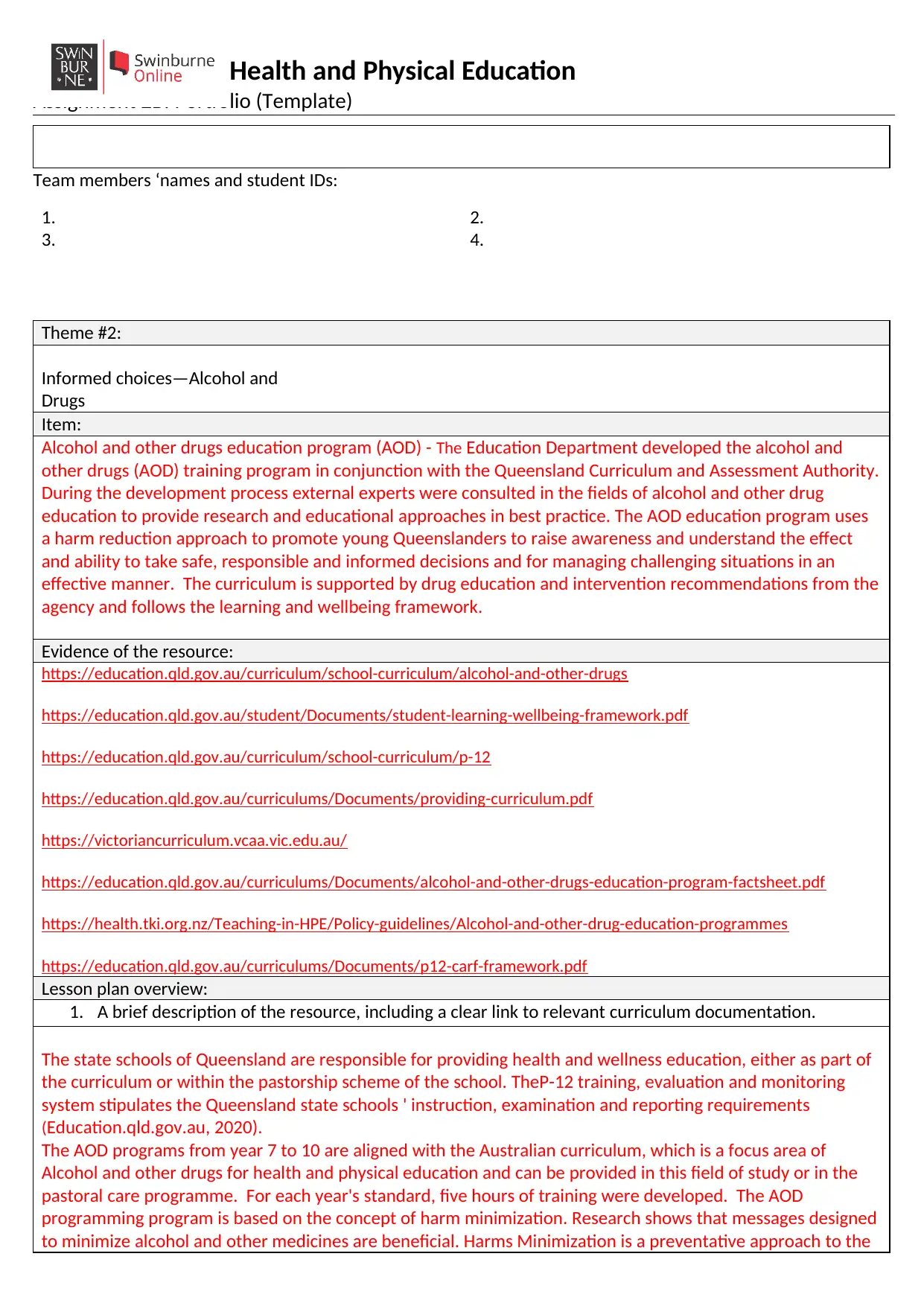
EDU30014: Health and Physical Education
Assignment 2B: Portfolio (Template)
Team members ‘names and student IDs:
1. 2.
3. 4.
Theme #2:
Informed choices—Alcohol and
Drugs
Item:
Alcohol and other drugs education program (AOD) - The Education Department developed the alcohol and
other drugs (AOD) training program in conjunction with the Queensland Curriculum and Assessment Authority.
During the development process external experts were consulted in the fields of alcohol and other drug
education to provide research and educational approaches in best practice. The AOD education program uses
a harm reduction approach to promote young Queenslanders to raise awareness and understand the effect
and ability to take safe, responsible and informed decisions and for managing challenging situations in an
effective manner. The curriculum is supported by drug education and intervention recommendations from the
agency and follows the learning and wellbeing framework.
Evidence of the resource:
https://education.qld.gov.au/curriculum/school-curriculum/alcohol-and-other-drugs
https://education.qld.gov.au/student/Documents/student-learning-wellbeing-framework.pdf
https://education.qld.gov.au/curriculum/school-curriculum/p-12
https://education.qld.gov.au/curriculums/Documents/providing-curriculum.pdf
https://victoriancurriculum.vcaa.vic.edu.au/
https://education.qld.gov.au/curriculums/Documents/alcohol-and-other-drugs-education-program-factsheet.pdf
https://health.tki.org.nz/Teaching-in-HPE/Policy-guidelines/Alcohol-and-other-drug-education-programmes
https://education.qld.gov.au/curriculums/Documents/p12-carf-framework.pdf
Lesson plan overview:
1. A brief description of the resource, including a clear link to relevant curriculum documentation.
The state schools of Queensland are responsible for providing health and wellness education, either as part of
the curriculum or within the pastorship scheme of the school. TheP-12 training, evaluation and monitoring
system stipulates the Queensland state schools ' instruction, examination and reporting requirements
(Education.qld.gov.au, 2020).
The AOD programs from year 7 to 10 are aligned with the Australian curriculum, which is a focus area of
Alcohol and other drugs for health and physical education and can be provided in this field of study or in the
pastoral care programme. For each year's standard, five hours of training were developed. The AOD
programming program is based on the concept of harm minimization. Research shows that messages designed
to minimize alcohol and other medicines are beneficial. Harms Minimization is a preventative approach to the
Assignment 2B: Portfolio (Template)
Team members ‘names and student IDs:
1. 2.
3. 4.
Theme #2:
Informed choices—Alcohol and
Drugs
Item:
Alcohol and other drugs education program (AOD) - The Education Department developed the alcohol and
other drugs (AOD) training program in conjunction with the Queensland Curriculum and Assessment Authority.
During the development process external experts were consulted in the fields of alcohol and other drug
education to provide research and educational approaches in best practice. The AOD education program uses
a harm reduction approach to promote young Queenslanders to raise awareness and understand the effect
and ability to take safe, responsible and informed decisions and for managing challenging situations in an
effective manner. The curriculum is supported by drug education and intervention recommendations from the
agency and follows the learning and wellbeing framework.
Evidence of the resource:
https://education.qld.gov.au/curriculum/school-curriculum/alcohol-and-other-drugs
https://education.qld.gov.au/student/Documents/student-learning-wellbeing-framework.pdf
https://education.qld.gov.au/curriculum/school-curriculum/p-12
https://education.qld.gov.au/curriculums/Documents/providing-curriculum.pdf
https://victoriancurriculum.vcaa.vic.edu.au/
https://education.qld.gov.au/curriculums/Documents/alcohol-and-other-drugs-education-program-factsheet.pdf
https://health.tki.org.nz/Teaching-in-HPE/Policy-guidelines/Alcohol-and-other-drug-education-programmes
https://education.qld.gov.au/curriculums/Documents/p12-carf-framework.pdf
Lesson plan overview:
1. A brief description of the resource, including a clear link to relevant curriculum documentation.
The state schools of Queensland are responsible for providing health and wellness education, either as part of
the curriculum or within the pastorship scheme of the school. TheP-12 training, evaluation and monitoring
system stipulates the Queensland state schools ' instruction, examination and reporting requirements
(Education.qld.gov.au, 2020).
The AOD programs from year 7 to 10 are aligned with the Australian curriculum, which is a focus area of
Alcohol and other drugs for health and physical education and can be provided in this field of study or in the
pastoral care programme. For each year's standard, five hours of training were developed. The AOD
programming program is based on the concept of harm minimization. Research shows that messages designed
to minimize alcohol and other medicines are beneficial. Harms Minimization is a preventative approach to the
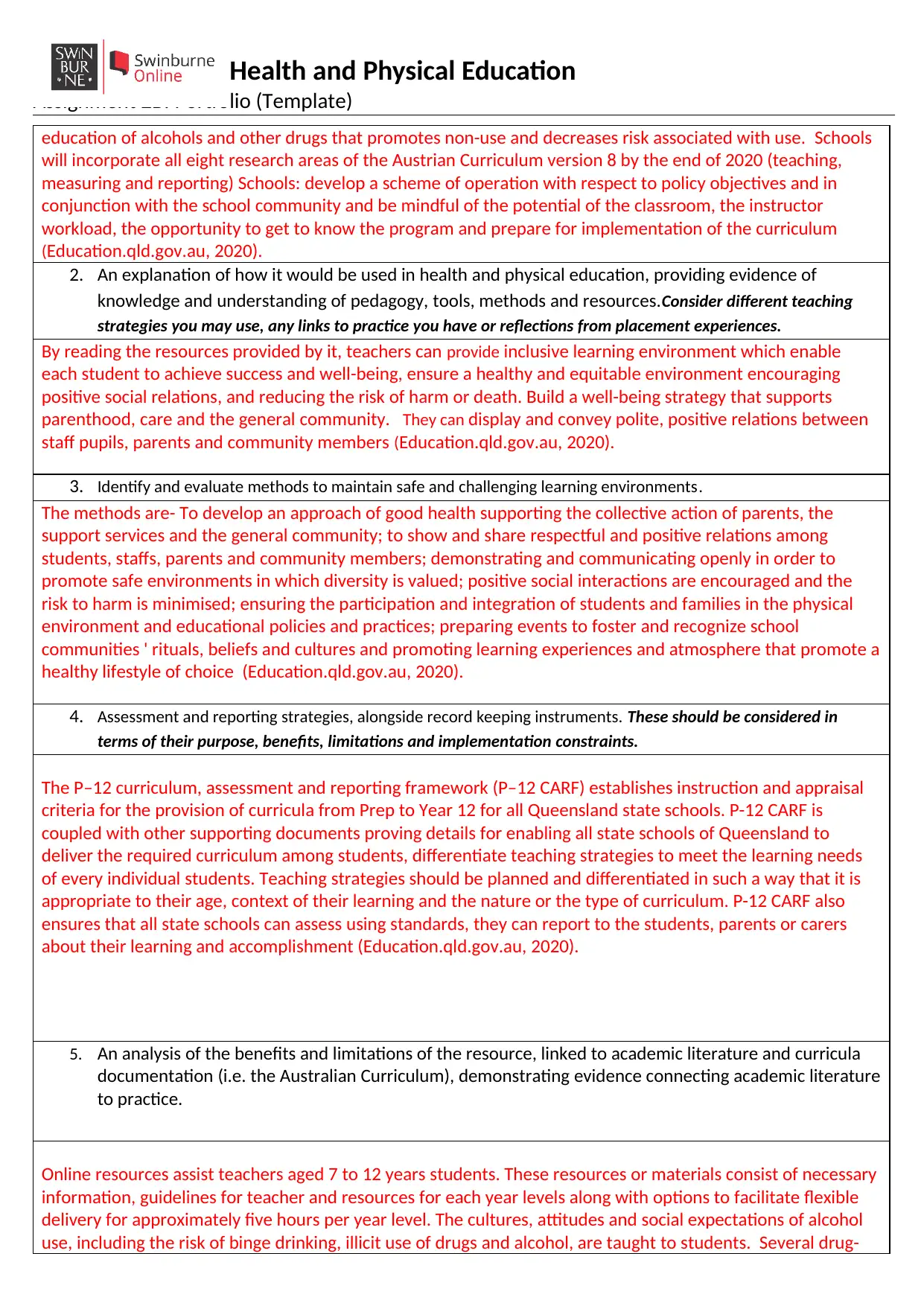
EDU30014: Health and Physical Education
Assignment 2B: Portfolio (Template)
education of alcohols and other drugs that promotes non-use and decreases risk associated with use. Schools
will incorporate all eight research areas of the Austrian Curriculum version 8 by the end of 2020 (teaching,
measuring and reporting) Schools: develop a scheme of operation with respect to policy objectives and in
conjunction with the school community and be mindful of the potential of the classroom, the instructor
workload, the opportunity to get to know the program and prepare for implementation of the curriculum
(Education.qld.gov.au, 2020).
2. An explanation of how it would be used in health and physical education, providing evidence of
knowledge and understanding of pedagogy, tools, methods and resources.Consider different teaching
strategies you may use, any links to practice you have or reflections from placement experiences.
By reading the resources provided by it, teachers can provide inclusive learning environment which enable
each student to achieve success and well-being, ensure a healthy and equitable environment encouraging
positive social relations, and reducing the risk of harm or death. Build a well-being strategy that supports
parenthood, care and the general community. They can display and convey polite, positive relations between
staff pupils, parents and community members (Education.qld.gov.au, 2020).
3. Identify and evaluate methods to maintain safe and challenging learning environments.
The methods are- To develop an approach of good health supporting the collective action of parents, the
support services and the general community; to show and share respectful and positive relations among
students, staffs, parents and community members; demonstrating and communicating openly in order to
promote safe environments in which diversity is valued; positive social interactions are encouraged and the
risk to harm is minimised; ensuring the participation and integration of students and families in the physical
environment and educational policies and practices; preparing events to foster and recognize school
communities ' rituals, beliefs and cultures and promoting learning experiences and atmosphere that promote a
healthy lifestyle of choice (Education.qld.gov.au, 2020).
4. Assessment and reporting strategies, alongside record keeping instruments. These should be considered in
terms of their purpose, benefits, limitations and implementation constraints.
The P–12 curriculum, assessment and reporting framework (P–12 CARF) establishes instruction and appraisal
criteria for the provision of curricula from Prep to Year 12 for all Queensland state schools. P-12 CARF is
coupled with other supporting documents proving details for enabling all state schools of Queensland to
deliver the required curriculum among students, differentiate teaching strategies to meet the learning needs
of every individual students. Teaching strategies should be planned and differentiated in such a way that it is
appropriate to their age, context of their learning and the nature or the type of curriculum. P-12 CARF also
ensures that all state schools can assess using standards, they can report to the students, parents or carers
about their learning and accomplishment (Education.qld.gov.au, 2020).
5. An analysis of the benefits and limitations of the resource, linked to academic literature and curricula
documentation (i.e. the Australian Curriculum), demonstrating evidence connecting academic literature
to practice.
Online resources assist teachers aged 7 to 12 years students. These resources or materials consist of necessary
information, guidelines for teacher and resources for each year levels along with options to facilitate flexible
delivery for approximately five hours per year level. The cultures, attitudes and social expectations of alcohol
use, including the risk of binge drinking, illicit use of drugs and alcohol, are taught to students. Several drug-
Assignment 2B: Portfolio (Template)
education of alcohols and other drugs that promotes non-use and decreases risk associated with use. Schools
will incorporate all eight research areas of the Austrian Curriculum version 8 by the end of 2020 (teaching,
measuring and reporting) Schools: develop a scheme of operation with respect to policy objectives and in
conjunction with the school community and be mindful of the potential of the classroom, the instructor
workload, the opportunity to get to know the program and prepare for implementation of the curriculum
(Education.qld.gov.au, 2020).
2. An explanation of how it would be used in health and physical education, providing evidence of
knowledge and understanding of pedagogy, tools, methods and resources.Consider different teaching
strategies you may use, any links to practice you have or reflections from placement experiences.
By reading the resources provided by it, teachers can provide inclusive learning environment which enable
each student to achieve success and well-being, ensure a healthy and equitable environment encouraging
positive social relations, and reducing the risk of harm or death. Build a well-being strategy that supports
parenthood, care and the general community. They can display and convey polite, positive relations between
staff pupils, parents and community members (Education.qld.gov.au, 2020).
3. Identify and evaluate methods to maintain safe and challenging learning environments.
The methods are- To develop an approach of good health supporting the collective action of parents, the
support services and the general community; to show and share respectful and positive relations among
students, staffs, parents and community members; demonstrating and communicating openly in order to
promote safe environments in which diversity is valued; positive social interactions are encouraged and the
risk to harm is minimised; ensuring the participation and integration of students and families in the physical
environment and educational policies and practices; preparing events to foster and recognize school
communities ' rituals, beliefs and cultures and promoting learning experiences and atmosphere that promote a
healthy lifestyle of choice (Education.qld.gov.au, 2020).
4. Assessment and reporting strategies, alongside record keeping instruments. These should be considered in
terms of their purpose, benefits, limitations and implementation constraints.
The P–12 curriculum, assessment and reporting framework (P–12 CARF) establishes instruction and appraisal
criteria for the provision of curricula from Prep to Year 12 for all Queensland state schools. P-12 CARF is
coupled with other supporting documents proving details for enabling all state schools of Queensland to
deliver the required curriculum among students, differentiate teaching strategies to meet the learning needs
of every individual students. Teaching strategies should be planned and differentiated in such a way that it is
appropriate to their age, context of their learning and the nature or the type of curriculum. P-12 CARF also
ensures that all state schools can assess using standards, they can report to the students, parents or carers
about their learning and accomplishment (Education.qld.gov.au, 2020).
5. An analysis of the benefits and limitations of the resource, linked to academic literature and curricula
documentation (i.e. the Australian Curriculum), demonstrating evidence connecting academic literature
to practice.
Online resources assist teachers aged 7 to 12 years students. These resources or materials consist of necessary
information, guidelines for teacher and resources for each year levels along with options to facilitate flexible
delivery for approximately five hours per year level. The cultures, attitudes and social expectations of alcohol
use, including the risk of binge drinking, illicit use of drugs and alcohol, are taught to students. Several drug-
Secure Best Marks with AI Grader
Need help grading? Try our AI Grader for instant feedback on your assignments.
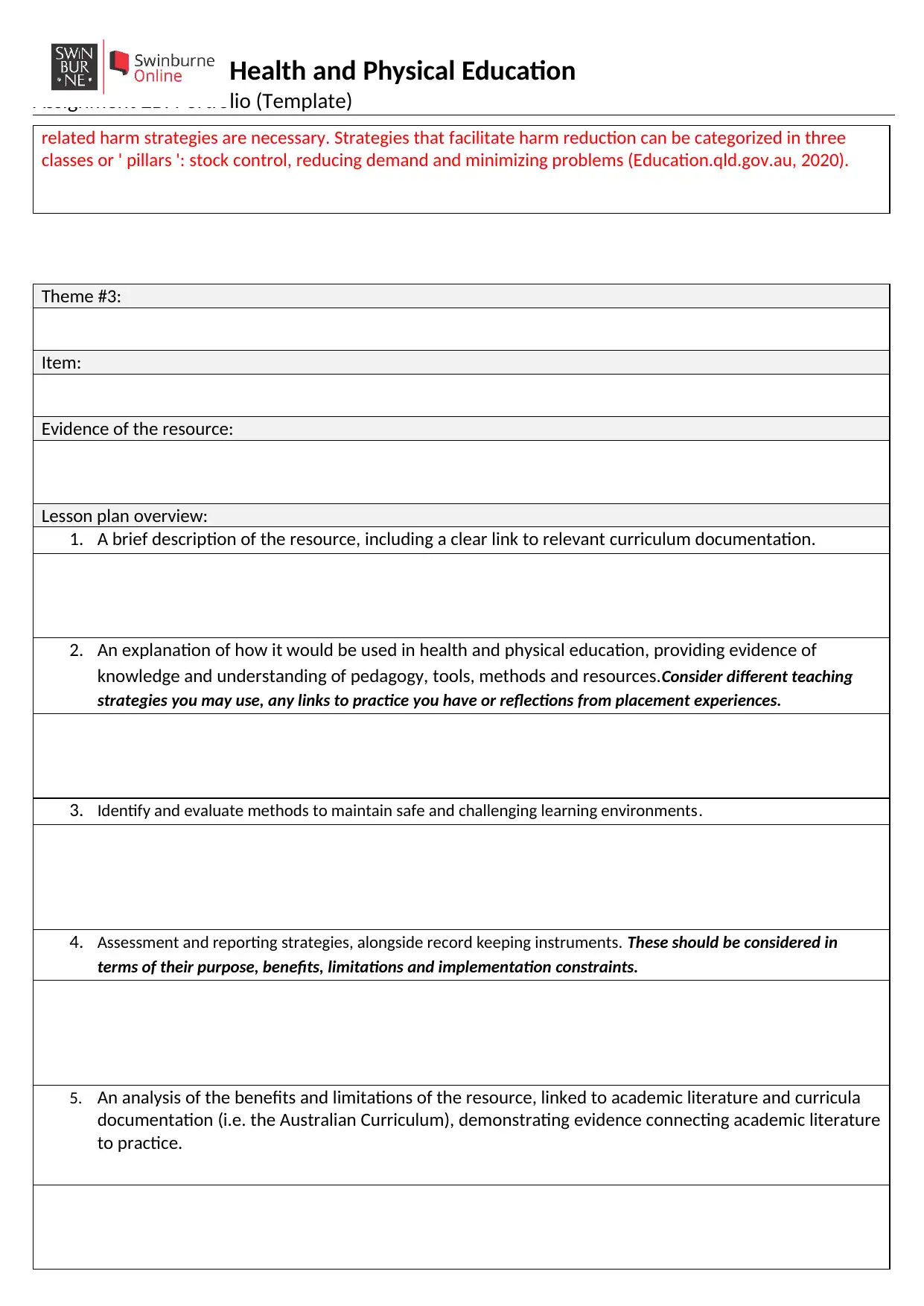
EDU30014: Health and Physical Education
Assignment 2B: Portfolio (Template)
related harm strategies are necessary. Strategies that facilitate harm reduction can be categorized in three
classes or ' pillars ': stock control, reducing demand and minimizing problems (Education.qld.gov.au, 2020).
Theme #3:
Item:
Evidence of the resource:
Lesson plan overview:
1. A brief description of the resource, including a clear link to relevant curriculum documentation.
2. An explanation of how it would be used in health and physical education, providing evidence of
knowledge and understanding of pedagogy, tools, methods and resources.Consider different teaching
strategies you may use, any links to practice you have or reflections from placement experiences.
3. Identify and evaluate methods to maintain safe and challenging learning environments.
4. Assessment and reporting strategies, alongside record keeping instruments. These should be considered in
terms of their purpose, benefits, limitations and implementation constraints.
5. An analysis of the benefits and limitations of the resource, linked to academic literature and curricula
documentation (i.e. the Australian Curriculum), demonstrating evidence connecting academic literature
to practice.
Assignment 2B: Portfolio (Template)
related harm strategies are necessary. Strategies that facilitate harm reduction can be categorized in three
classes or ' pillars ': stock control, reducing demand and minimizing problems (Education.qld.gov.au, 2020).
Theme #3:
Item:
Evidence of the resource:
Lesson plan overview:
1. A brief description of the resource, including a clear link to relevant curriculum documentation.
2. An explanation of how it would be used in health and physical education, providing evidence of
knowledge and understanding of pedagogy, tools, methods and resources.Consider different teaching
strategies you may use, any links to practice you have or reflections from placement experiences.
3. Identify and evaluate methods to maintain safe and challenging learning environments.
4. Assessment and reporting strategies, alongside record keeping instruments. These should be considered in
terms of their purpose, benefits, limitations and implementation constraints.
5. An analysis of the benefits and limitations of the resource, linked to academic literature and curricula
documentation (i.e. the Australian Curriculum), demonstrating evidence connecting academic literature
to practice.
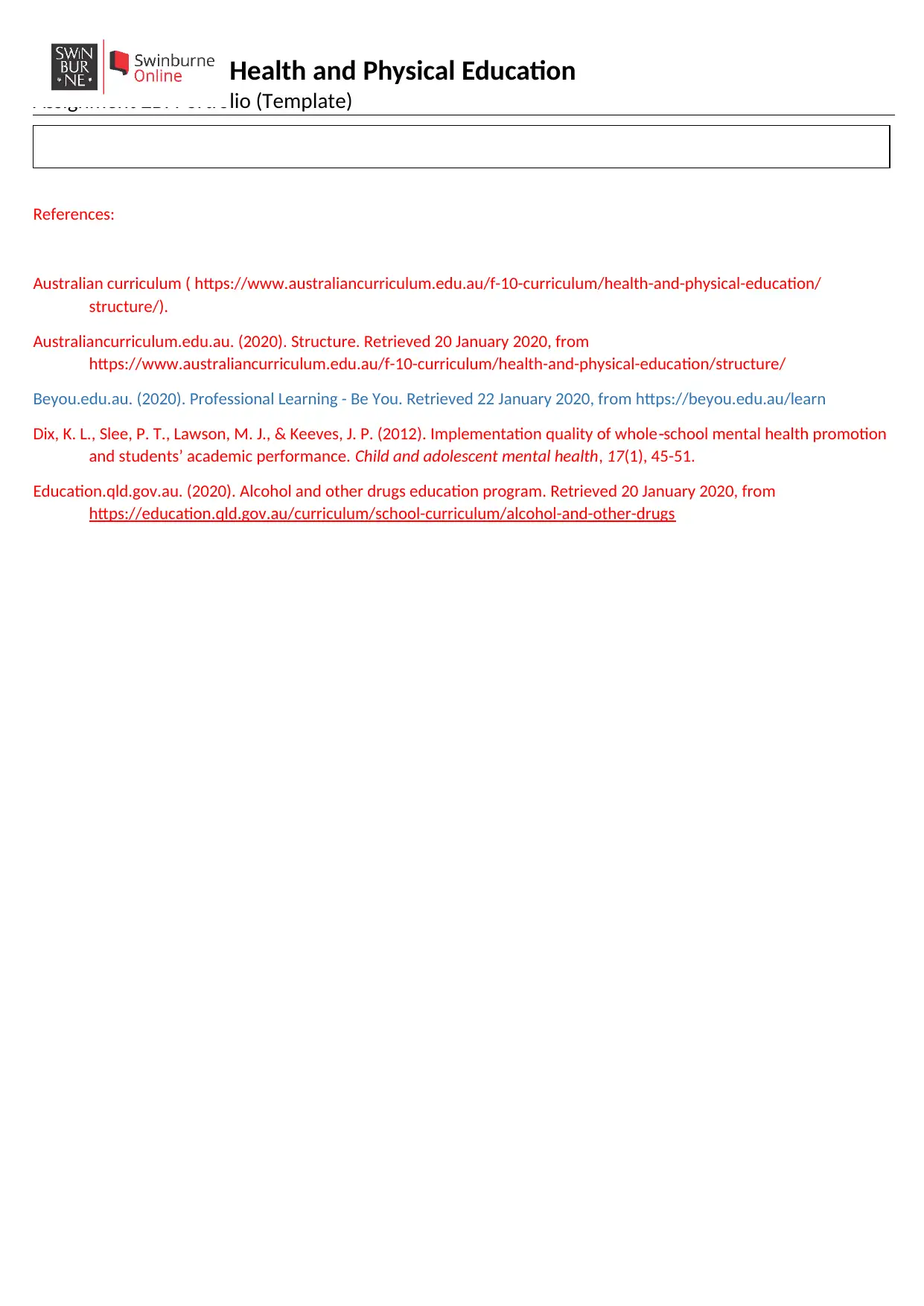
EDU30014: Health and Physical Education
Assignment 2B: Portfolio (Template)
References:
Australian curriculum ( https://www.australiancurriculum.edu.au/f-10-curriculum/health-and-physical-education/
structure/).
Australiancurriculum.edu.au. (2020). Structure. Retrieved 20 January 2020, from
https://www.australiancurriculum.edu.au/f-10-curriculum/health-and-physical-education/structure/
Beyou.edu.au. (2020). Professional Learning - Be You. Retrieved 22 January 2020, from https://beyou.edu.au/learn
Dix, K. L., Slee, P. T., Lawson, M. J., & Keeves, J. P. (2012). Implementation quality of whole school mental health promotion‐
and students’ academic performance. Child and adolescent mental health, 17(1), 45-51.
Education.qld.gov.au. (2020). Alcohol and other drugs education program. Retrieved 20 January 2020, from
https://education.qld.gov.au/curriculum/school-curriculum/alcohol-and-other-drugs
Assignment 2B: Portfolio (Template)
References:
Australian curriculum ( https://www.australiancurriculum.edu.au/f-10-curriculum/health-and-physical-education/
structure/).
Australiancurriculum.edu.au. (2020). Structure. Retrieved 20 January 2020, from
https://www.australiancurriculum.edu.au/f-10-curriculum/health-and-physical-education/structure/
Beyou.edu.au. (2020). Professional Learning - Be You. Retrieved 22 January 2020, from https://beyou.edu.au/learn
Dix, K. L., Slee, P. T., Lawson, M. J., & Keeves, J. P. (2012). Implementation quality of whole school mental health promotion‐
and students’ academic performance. Child and adolescent mental health, 17(1), 45-51.
Education.qld.gov.au. (2020). Alcohol and other drugs education program. Retrieved 20 January 2020, from
https://education.qld.gov.au/curriculum/school-curriculum/alcohol-and-other-drugs
1 out of 6
Related Documents
Your All-in-One AI-Powered Toolkit for Academic Success.
+13062052269
info@desklib.com
Available 24*7 on WhatsApp / Email
![[object Object]](/_next/static/media/star-bottom.7253800d.svg)
Unlock your academic potential
© 2024 | Zucol Services PVT LTD | All rights reserved.




